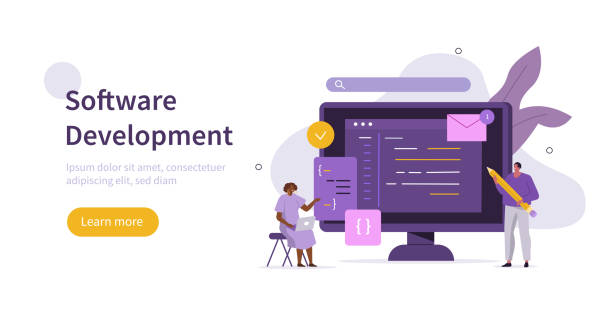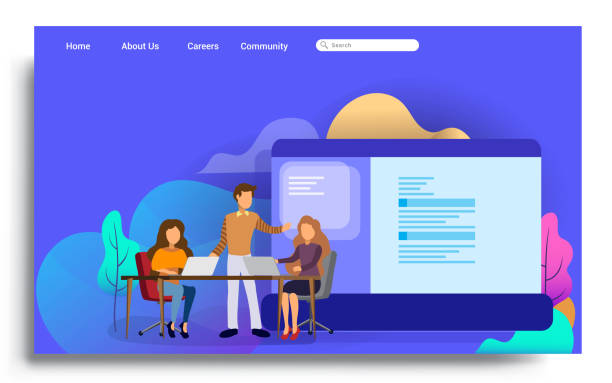Introduction to the Importance of Secure Website Design

In the information age, an online presence is an undeniable necessity for businesses and individuals.
However, with the increasing volume of data and online transactions, the importance of #secure_website_design becomes more evident than ever.
An insecure website can not only jeopardize sensitive user information but also severely damage a business’s reputation and credibility.
Cyberattacks are becoming increasingly complex, and hackers are constantly looking for weaknesses in systems.
Therefore, a preventive approach to #website_security should be a priority for every developer.
The concept of cybersecurity goes beyond installing a firewall or an SSL certificate; it is a comprehensive process that begins with the initial stages of planning and design and continues constantly with maintenance and updates.
Education and awareness play a vital role in this field so that both developers and users are aware of potential risks.
Failure to address this issue can lead to #data_theft, data loss, and irreparable financial and reputational damages.
For this reason, anyone or any organization intending to establish an online presence must consider the principles of secure website design as the backbone of their project.
This guide will help you get acquainted with the basic and advanced steps in this journey.
Is your online sales not as expected? With RasaWeb, solve the problem of low sales and poor user experience forever!
✅ Increase visitor-to-customer conversion rate
✅ Create a pleasant user experience and boost customer trust
⚡ Act now to receive a free consultation!
Common Web Security Threats and How to Identify Them

Understanding common threats is the first step towards secure website design.
Attackers use various methods to infiltrate systems.
Among the most common attacks is SQL Injection, where the attacker injects malicious SQL code through user inputs to gain access to the database.
Another very common attack is XSS (Cross-Site Scripting), in which malicious JavaScript codes are executed in the victim’s browser.
DDoS (Distributed Denial of Service) attacks also aim to take a site offline through a flood of traffic.
Identifying these threats requires specialized knowledge and the use of analytical tools.
Vulnerability scanner programs and penetration testing tools can help discover weaknesses.
Server log analysis and traffic monitoring also provide valuable information about suspicious activities.
Did you know that even an old and unupdated plugin can be a gateway for serious attacks? It is questionable why many website administrators do not pay enough attention to the importance of security updates.
Awareness of the latest news and attack methods is crucial for anyone involved in secure website design.
This section delves deeper into these threats and ways to counter them.
Basic Principles of Secure Website Design and Secure Development

Secure website design begins from the very first stages of development and requires adherence to specific principles.
One of the most important of these principles is Input Validation; any data received from the user must be carefully checked and sanitized to prevent the injection of malicious code.
Another principle is Output Encoding to prevent the execution of unwanted JavaScript code in the user’s browser.
The Principle of Least Privilege is also crucial; meaning that each user or system component should only have access to the minimum resources necessary to perform their task.
Using reputable and up-to-date frameworks and libraries that have built-in security features can facilitate the secure development process.
Careful security architecture planning before starting to code prevents many vulnerabilities.
This educational and guidance approach helps developers to think about security from the very beginning.
| Item | Description | Status |
|---|---|---|
| Input Validation | Reviewing and sanitizing all user input data. | Done |
| Communication Encryption (HTTPS) | Ensuring the use of SSL/TLS for all pages. | Done |
| Secure Session Management | Using secure tokens and terminating inactive sessions. | Done |
| Regular Updates | Ensuring the operating system, framework, and plugins are up-to-date. | Done |
| Error Handling and Logging | Displaying general error messages and logging details for the administrator. | Done |
| Implementing the Principle of Least Privilege for users and systems. | Done |
Choosing Secure Technologies and Encryption Protocols

One of the main pillars of secure website design is the precise and intelligent selection of security technologies and protocols.
In today’s world, the use of HTTPS is a requirement for any website.
HTTPS, by using SSL/TLS protocols, encrypts the communication between the user’s browser and the server, preventing eavesdropping and data tampering.
This not only enhances security but also positively impacts SEO.
Furthermore, selecting programming languages and frameworks with strong community support and regular security updates is of high importance.
For example, using older versions of PHP or other languages can expose your site to known vulnerabilities.
Also, choosing strong encryption algorithms for storing passwords and sensitive information in the database, such as Bcrypt or Argon2 instead of the deprecated MD5 or SHA-1, is crucial.
Never store user passwords in plain text.
This section explains how to correctly choose these technologies and how to properly implement them in secure website design projects.
Correct choices at this stage can largely prevent cyberattacks and enhance the overall security level of the site.
Did you know that a weak corporate website takes many opportunities from you daily? With professional corporate website design by RasaWeb, solve this problem forever!
✅ Create a powerful and reliable image for your brand
✅ Targeted attraction of new customers and increased sales
⚡ [Get a free website design consultation]
Database Management and Sensitive Information Security

The database is the heart of any website, containing critical and sensitive information about users and business operations.
Therefore, secure website design would be incomplete without special attention to database security.
One of the first measures is data encryption, both data at rest and data in transit.
Using secure protocols for connecting to the database and preventing direct access to it from outside, is essential.
Also, user accounts with the least privilege should be used for applications to communicate with the database, and root or administrative access should be avoided for applications.
Regular and encrypted backups of the database, stored in secure and separate locations, are a critical defense layer against data loss in case of cyberattacks or system errors.
Proper session management and the use of parameterized queries to prevent SQL Injection attacks are also fundamental principles.
This specialized section guides you on how to secure your database against various threats and ensure that sensitive user information is protected in the best possible way.
Have you ever wondered about the devastating consequences if your database information falls into the wrong hands?
The Role of Authentication and Access Management in Website Security

Authentication and access management are two fundamental elements in secure website design that determine who can access which resources.
Strong authentication involves requiring complex passwords, using Multi-Factor Authentication (MFA) mechanisms, and preventing Brute Force attacks through login attempt limitations.
Session Management systems must also be properly implemented to prevent Session Hijacking; this includes using secure session tokens with limited lifetimes.
Regarding access management, implementing Role-Based Access Control (RBAC) means that each user only has access to the parts of the site necessary to perform their duties.
This analytical approach helps reduce the attack surface.
Imagine an employee with limited access gaining access to confidential financial information; such a scenario demonstrates the importance of access segregation.
This section provides practical guidance for implementing strong authentication and access management systems to ensure that only authorized individuals have access to sensitive information and functionalities, which are vital components of secure website design.
Penetration Testing and Vulnerability Assessment

After implementing the principles of secure website design, the next and very crucial step is continuous security testing and assessment.
Penetration Testing is a process where security specialists (ethical hackers) try to discover system weaknesses and vulnerabilities using methods employed by real attackers.
These tests can be performed as Black-Box, White-Box, or Gray-Box, each providing a different level of information to the tester.
Vulnerability Assessment also involves using automated scanners to identify known vulnerabilities.
These tools regularly update their databases to identify the latest threats.
This specialized and analytical process not only helps identify problems but also provides insight into the potential for future attacks.
Regularly performing these tests is an informed and up-to-date approach to maintaining site security.
Did you know that even with all security principles followed, new vulnerabilities can be discovered every day? This highlights the importance of continuous monitoring and testing.
| Tool | Usage | Type |
|---|---|---|
| OWASP ZAP | Open-source web application vulnerability scanner. | Automated Scanner |
| Burp Suite | Integrated platform for web application security testing. | Manual and Automated Tool |
| Nmap | Network discovery and port scanning tool. | Network Scanner |
| Metasploit Framework | Framework for developing and executing exploits. | Penetration Tool |
| Nikto | Web server scanner for identifying vulnerabilities and configuration errors. | Automated Scanner |
| SQLMap | SQL injection automation tool. | Penetration Tool |
Dealing with Cyberattacks and Data Recovery

Even with the best approaches to secure website design, the probability of a cyberattack is not zero.
Therefore, having a comprehensive Incident Response Plan is crucial for any organization.
This plan should include specific steps for identifying the attack, containing it, root cause analysis and system cleanup, and finally, recovery and return to normal operation.
Regular and off-site backups of data and code are among the most important measures for rapid recovery after an attack.
Digital Forensics investigations can help identify how the attack occurred and the attackers, which is useful information for future security improvements and even legal prosecution.
This informative and guiding section emphasizes the importance of preparedness and having a clear strategy to face the worst-case scenarios.
Are you ready to act quickly and effectively if an attack occurs? How can you ensure your site recovers quickly and with minimal damage after an attack? These challenging questions highlight the importance of proactive planning alongside reactive measures in secure website design.
Does your current e-commerce website not generate the sales you expect?
RasaWeb specializes in professional e-commerce website design!
✅ An attractive and user-friendly website aimed at increasing sales
✅ High speed and security for an ideal shopping experience⚡ Get a free online store design consultation with RasaWeb!
The Future of Web Security and Emerging Trends

The world of cybersecurity is constantly evolving, and secure website design must keep pace with these changes.
Emerging trends such as the use of Artificial Intelligence and Machine Learning in detecting and preventing cyberattacks promise smarter and more automated solutions.
Blockchain technology also has high potential in increasing data security and transparency, especially in areas like decentralized authentication and identity management.
Zero Trust Architecture, which is based on the premise that no user or device, whether inside or outside the network, can be trusted unless their identity and permissions are continuously verified, is becoming a new standard.
This paradigm shift will revolutionize our view of security.
Are we ready to embrace these changes and invest in new technologies? This analytical and engaging section explores these trends and raises questions that shape the future of secure website design.
These developments can help us combat more complex threats and create a safer digital environment for everyone.
Conclusion and Final Recommendations for Secure Website Design

In this comprehensive guide, we explored various aspects of secure website design, from its fundamental importance to how to deal with threats and the future of web security.
The most important lesson is that security is a journey, not a destination.
It is a continuous process that requires regular updates, continuous monitoring, and ongoing education.
To ensure your site’s security, always follow best security practices, use reputable tools, and keep your knowledge up-to-date on the latest threats and solutions.
No system is 100% impenetrable, but by adhering to strong secure website design principles and having a robust incident response strategy, you can minimize risks and be more resilient against potential attacks.
Remember that investing in security is an investment in your business’s credibility and future.
This final educational recommendation assures you that with a comprehensive approach, you can have a secure and reliable presence in the digital world.
Frequently Asked Questions
| Question | Answer |
|---|---|
| 1. What does secure website design mean? | Secure website design means creating a website that is resistant to cyberattacks and protects user and server information. |
| 2. Why is security important in website design? | To prevent data breaches, maintain user privacy, preserve user trust, and avoid financial and reputational losses. |
| 3. What are the most common web vulnerabilities? | SQL Injection, Cross-Site Scripting (XSS), Cross-Site Request Forgery (CSRF), Broken Authentication, and Security Misconfiguration. |
| 4. How can SQL Injection be prevented? | By using Prepared Statements / Parameterized Queries, ORMs, and Input Validation. |
| 5. What is the role of HTTPS and SSL/TLS in website security? | HTTPS uses the SSL/TLS protocol to encrypt communication between the user’s browser and the server, preventing eavesdropping and data manipulation. |
| 6. What measures should be taken to prevent XSS attacks? | Input validation, Output Encoding to prevent malicious code execution, and using Content Security Policy (CSP). |
| 7. What does a strong password policy include? | Requiring long passwords, a combination of uppercase and lowercase letters, numbers, and special characters, and preventing reuse. |
| 8. How does Two-Factor Authentication (2FA) help with security? | Even if the user’s password is compromised, the attacker cannot access the account without access to the second authentication factor (e.g., SMS code or app). |
| 9. What is a Web Application Firewall (WAF) and what is its use? | A WAF is a firewall that monitors and filters HTTP traffic between a web application and the Internet to prevent common web attacks such as SQL injection and XSS. |
| 10. Why are regular updates of software and libraries important? | Updates often include security patches to fix discovered vulnerabilities. Failure to update can expose the site to new attacks. |
And other services of RasaWeb Advertising Agency in the field of advertising
Smart Social Media: A professional solution to increase click-through rates with a focus on custom programming.
Smart Custom Software: A fast and efficient solution for customer acquisition with a focus on marketing automation.
Smart Direct Marketing: An exclusive service for SEO rank improvement based on attractive user interface design.
Smart Sales Automation: An innovative service for increasing click-through rates through Google Ads management.
Smart SEO: Revolutionize SEO rank improvement with the help of custom programming.
And over hundreds of other services in the field of online advertising, advertising consulting, and organizational solutions
Online Advertising | Advertising Strategy | Advertorial
Resources
Digikala Mag Website Security Article
IranServer Comprehensive Site Security Guide
Webramz Important Tips for Secure Site Design
ParsData Best Methods for Increasing Site Security
? Are you ready to revolutionize your business in the digital world? RasaWeb Afarin Digital Marketing Agency, by offering comprehensive and professional solutions, from personal website design to successful digital marketing campaigns, paves your way to reach the peak. With us, have a powerful and lasting presence in the online space.
📍 Tehran, Mirdamad Street, next to Bank Markazi, Southern Kazeroon Alley, Ramin Alley, No. 6




